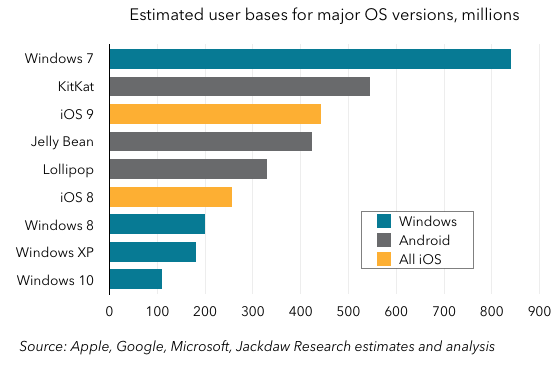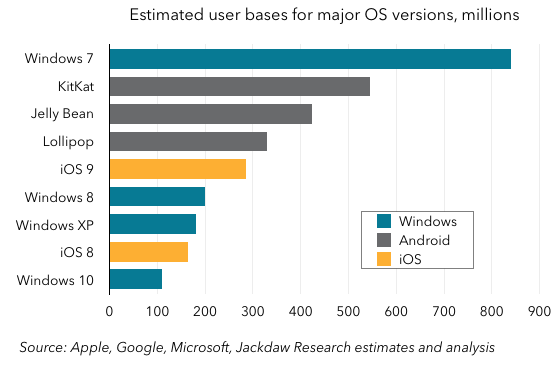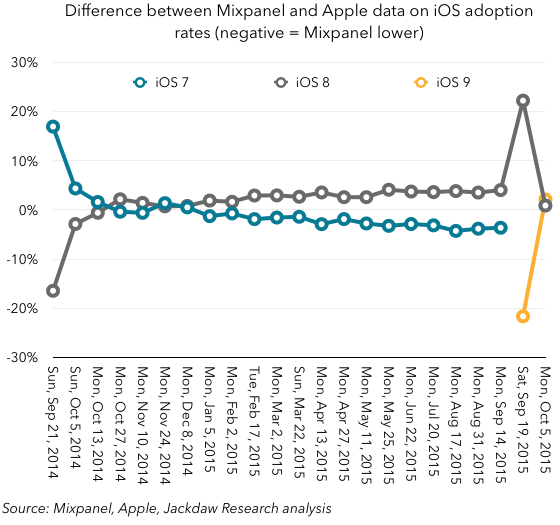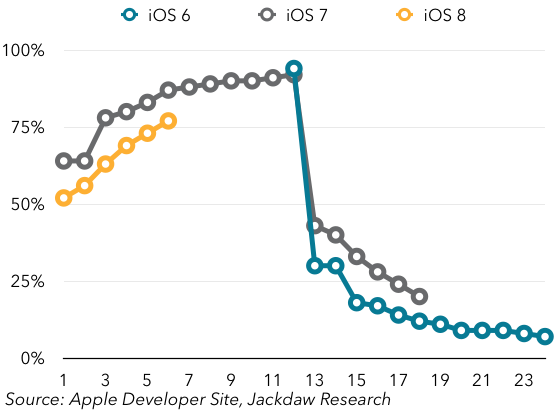Related: two previous posts on the patterns in Android adoption rates (December 2013, March 2014), a post contrasting iOS and Android adoption patterns, and a post from last month on iOS 9 adoption.
Both Apple and Google have just updated their mobile OS user stats, while Microsoft shared a new number for Windows 10 adoption at its event this week, giving us a rare opportunity to make some comparisons between these major operating systems at a single point in time. We now have the following stats straight from the sources:
- The stats provided by both Apple and Google on their developer sites with regard to the user distribution across their mobile operating systems (Android and iOS)
- The 110 million Windows 10 number provided by Microsoft this week
- The 1.4 billion total active Android user base number provided by Google at its event last week
- Total Windows users of around 1.5 billion, as reported by Microsoft several times at recent events.
In addition, there are various third party sources for additional data, including NetMarketShare and its estimate of the usage of other versions of Windows. Lastly, I have estimated that there are roughly 500 million iPhones in use now, and around 775 million iOS devices in use in total (including iPads and iPod Touches).
If we take all these data sets together, it’s possible to arrive at a reasonably good estimate for the actual global user bases of major operating system versions at the present time. The chart below shows the result of this analysis: There are several things worth noting here:
There are several things worth noting here:
- Each company has one entry in the top three, with Microsoft first, Google second, and Apple third.
- However, only one of these entrants is the latest version of that company’s operating system (iOS 9), while the other two are the third most recent versions (Windows 7 and Android KitKat).
- Google has three of the top six operating systems, none of which is its latest operating system (Marshmallow, released this past week). Even its second most recent version (Lollipop), now available for a year, is only the third most adopted version after KitKat and Jelly Bean.
- Both iOS 9 and iOS 8 and the three most used versions of Android beat out every version of Windows but Windows 7.
- The most recent versions of the three companies’ major operating systems are used by a little over 400 million (iOS 9), 110 million (Windows 10), and a negligible number (Android Marshmallow) respectively.
- The second most recent versions are used by around 330 million (Android Lollipop), around 250 million (iOS 8), and around 200 million (Windows 8) respectively.
There are lots more data points to tease out here, but to my mind it’s a striking illustration of the differences in the size and adoption rates of these three major operating systems.
Two additional thoughts
Just for interest, I’m including a couple of additional thoughts below.
First off, here’s the same chart, but with iOS reduced to just the iPhone base. The order changes a fair amount, but iOS 8 and iOS 9 still make a good showing:
 Lastly, I wanted to revisit my post from a couple of weeks ago about the initial adoption of iOS 9, especially as it relates to Mixpanel’s data. In that post, I showed how Mixpanel’s iOS adoption data tends to be pretty close to Apple’s own data except for the month or so after a new version of iOS ships, when it tends to skew way lower than Apple’s own data. Now that we’re a few weeks on from the initial launch, and Apple has released the second set of iOS adoption data since the launch, I wanted to revisit that pattern. Interestingly, the very same pattern is playing out again – despite the initial significant discrepancy, Mixpanel’s data is now once again very close to Apple’s own:
Lastly, I wanted to revisit my post from a couple of weeks ago about the initial adoption of iOS 9, especially as it relates to Mixpanel’s data. In that post, I showed how Mixpanel’s iOS adoption data tends to be pretty close to Apple’s own data except for the month or so after a new version of iOS ships, when it tends to skew way lower than Apple’s own data. Now that we’re a few weeks on from the initial launch, and Apple has released the second set of iOS adoption data since the launch, I wanted to revisit that pattern. Interestingly, the very same pattern is playing out again – despite the initial significant discrepancy, Mixpanel’s data is now once again very close to Apple’s own:
